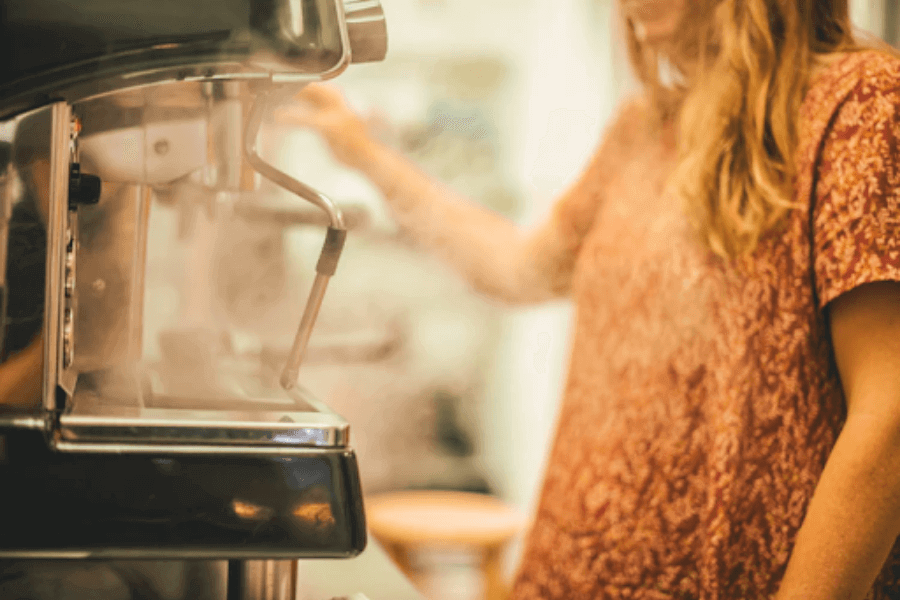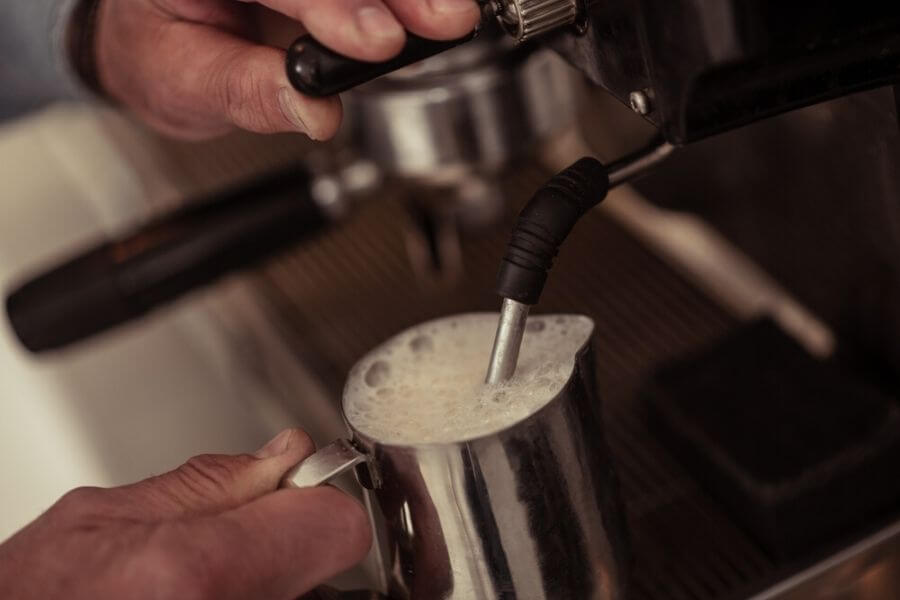How To Use a Milk Frother: Pro Tips and Tricks
Textured, frothy milk may not be unique to espresso, but it sure goes hand in hand with cafe-style coffees. If you want to create cappuccinos, flat whites, and lattes at home, learning how to use a milk frother is essential.
All you need is some practice and some intel on the right frothing techniques. In this guide, we show you exactly how to use a steam wand for perfect milk every time.
If you haven’t already, be sure to check out parts one and two of our series on home espresso-making: How to use an espresso machine and espresso machine maintenance.
Here’s what’s covered in this milk frothing how-to:
What Does a Milk Frother Do?
Milk frothers do as the name suggests: milk frothers froth milk. Say that ten times fast!
But there’s more than meets the eye. Frothers also add texture to milk by aerating it, that is, adding tiny air bubbles.
The result is a thickened, silky smooth consistency that can enhance your coffee experience. Foam is popular in a number of drinks, from carbonated soda and beer to nitro coffee.
Frothing doesn’t actually change the taste of milk, but the added texture can change how we perceive it. In other words, milk bubbles trick our brains into thinking that milk is sweeter.
But it’s not all about perception. If you froth milk with an espresso machine’s steam wand, the milk’s composition and therefore its flavor is affected.
There is a ton of science behind this, but it boils down to one simple fact: heat emphasizes sweetness. Think of how the flavor of coffee changes when it cools down.
Ice cream is a great example of this principle. If it’s frozen solid, it won’t taste as sweet as when it’s soft and scoopable.
Milk frothers add texture and make milk sweeter. This combination of creamy, piquant goodness is what makes milk foam in coffee so cozy and smooth.

Milk Frothers Versus Steam Wands: What’s the Difference?
These terms are used interchangeably, but milk frothers and steam wands are two different things, as are milk froth and steamed milk.
These differences are subtle and most of the time, the devices produce results so similar that it’s hard to tell them apart.
But since the devil is in the details and you came here to learn the ins and outs of frothing, here’s a quick look at each:
Milk Frothers Explained
Milk frothers introduce air to milk by disturbing it. They don’t generally heat milk, although nothing’s stopping you from frothing pre-heated milk. Manual milk frothers are common, but frothers come in all shapes and sizes with a variety of functions.
If the texture of your foam is important to you, frothers are the best option. They produce lighter, more aerated foam, and if you for a manual option, are easier to control.
One downside is that since the froth is lighter, it’s slightly more difficult to make latte art with milk frothers.
Steam Wands Explained
A steam wand (or steamer) is an integrated frother. Both commercial and home-use espresso machines can have steam wands. These devices use pressurized heat to warm, froth, and thicken the milk.
Steamers make excellent froth, but the result isn’t as airy or soft as it is with milk frothers. To compensate, steam wands are more consistent and produce better microfoam, so they’re preferred for latte art.
Milk Frother Tips
The concept of milk foam is simple enough, but there are some tricks to making it well.
Before you get started, here are some handy tips to help you master the art of textured milk:
Use cold milk – Your milk will froth faster and hold its texture for longer if you start with it chilled or at room temperature. You can froth warm milk if you’re using a manual frother, but it may require more effort. If you’re using a steam wand, remember that your milk will heat up in the process.
The fresher the better – There’s no need to milk a cow every single day, but fresh milk is easier to froth than milk that’s already open. If your opened milk is days old, it may not froth at all.
Dairy works best – The type of milk you use matters. Full-cream dairy is best because it contains proteins and sugars that help the process, and give milk froth its texture. If you don’t eat dairy, you can still make your milk froth, but it won’t be as easy or creamy. Oat milk is a plant-based option that offers a consistency similar to dairy milk.
Serve and enjoy immediately – Only froth what you will use. Texturing breaks down fats, sugars, and proteins, so round two will have a watery consistency and won’t taste as sweet. You also risk overheating your froth and trust me — I once burned my taste buds off because I was greedy for my coffee — and it’s not fun.
Keep your frothers clean – This is always important, but especially if you’re using dairy milk. Clean your frother or steam wand immediately after use. If you don’t, old milk will build up and harden, which is both unsanitary and frustrating to clean later. It will also smell and taint your coffee with a rancid milk flavor.

Milk Frother Techniques: Step By Step
Now that you understand the difference between milk frothers and steam wands, and know a little bit about what not to do, it’s time to get practical. Here’s how you can make your very own milk froth, the old-school way.
How To Use an Automatic Milk Frother
We’ll start with the easiest one. If you have an automatic milk frother, there are only five simple steps to follow. Bear in mind that automatic frothers will vary by manufacturer, so it’s best to read the manual to make the most of yours.
Step 1: Add milk to the frother.
Step 2: Program your settings (if you can).
Step 3: Hit the start button.
Step 4: Wait a moment.
Step 5: When your frother has done its job, pour the milk into your coffee.
How To Use a Milk Frother Wand
A handheld frother requires a little more technique. First things first, remember that a milk frother wand won’t warm your milk, so if you prefer it heated, prepare it first.
Secondly, don’t fill your mug to the brim unless you want milk to spray everywhere. When you’re ready, here’s how to use milk frother wands:
Step 1: While your frother is still off, place it in your milk (not too deep though).
Step 2: Press the button to get the frother running.
Step 3: Start frothing your milk from the top. This will incorporate more air into your froth.
Step 4: Once it starts to foam, slowly and gently move your frother up and down.
Step 5: When you’re happy with the consistency, turn your frother off while it’s still in your milk to prevent splashes.
Step 6: Pour your milk into your coffee, and if need be, scoop out any remaining foam with a spoon or spatula and place it on top of your joe. Voila!
How To Use A Steam Wand
An espresso machine’s milk frother (or espresso steam wand if we’re being precise) is easy to use. They have a reputation for being complicated because espresso machines are complicated. But espresso milk frothers are probably the easiest component to get the hang of in the whole setup!
As with automatic milk frothers, how you’ll operate your steam wand depends on the type of machine you have, so read your manual for exact information.
Here’s how to use a milk frother on an espresso machine. You can implement these techniques regardless of your model.
Step 1: Get your milk ready. Milk pitchers are perfect for use with steam wands.
Step 2: If you have a programmable machine, set the steam’s temperature and pressure. Optimal steam temperatures are between 140 and 160 Fahrenheit. Any warmer and you’ll burn your mouth, any cooler and it could compromise your coffee’s temperature. As for pressure, between 1.1 and 1.3 bars is more than enough.
Step 3: Purge your steam wand to removes any water droplets that will interfere with your milk. To do this, run your steam wand for about five seconds. Note that condensation might drip from the spout, so have a cloth or ready to catch it.
Step 4: When nothing but steam exits your wand, it’s time to froth.
Step 5: Place the spout of the wand inside the milk, close to the top of the pitcher. Your pitcher should be at a slight angle, and the wand’s tip should be fully submerged.
Step 6: Run your steamer. Try to position the wand slightly to one side of your pitcher. This creates a better whirlpool and aeration.
Step 7: Slowly and carefully swirl your pitcher around the spout.
Step 8: When you’re happy with your level of microfoam, lift your pitcher so the steamer reaches, warms, and textures as much milk as possible.
Step 9: When you’re happy with your froth’s consistency, turn off your steamer. There is no golden rule here, except to not froth your milk to the point that it’s stiff. You want a light, smooth texture, not whipped cream.
Step 10: As with frothers, pour your milk into your espresso, and scoop whatever’s left out to top off your drink.

How To Make Latte Art at Home
One of the best parts of having an espresso machine with a milk frother is that you can make Pinterest-worthy latte art in your kitchen. It will take some practice (and I recommend you watch some professional tutorials if you’re serious about it), but it’s not as tricky as it looks.
Here are the basics of how to create latte art at home.
Find your design – If you need inspiration, try searching the internet (Pinterest and Instagram are great) for designs. Start simple; leaves, flowers, spirals, and hearts are super easy and perfect for beginners.
Stock up tools if need be – You can purchase latte art stencils if you don’t trust your talent. Find them at kitchen craft or department stores craft stores. They’re affordable and will ensure magical art. You might want to pick up some skewers as well. These will help you create more intricate shapes.
Prepare your coffee and foam – As advised above, pull your espresso shot and get your milk foam ready.
Pour from higher up – You want your stream to be thin and smooth, so lift your pitcher a little bit higher so it doesn’t flow out as one big blob.
Control the milk flow to make art – Latte art is created by controlling where the milk falls on your crema. You can pour it into any shape you like. Again, try something simple to start off.
Keep it steady – Pour your milk slowly and try to keep your hand as steady as possible.
Use a skewer – Draw your designs into your foam or to straighten out lines.
Dust it off – If you want to be fancy, try sprinkling some cocoa or cinnamon over your design. With a firm hand, you can create cool shapes with these dustings too.
Remember that steam wands are preferable for latte art as they create microfoam. It’s smoother, firmer, and easier to pour into shapes. Don’t forget to practice. You’ll have cafe-quality espresso in no time!
Conclusion
Milk frothers are one of the coolest coffee tools you can invest in. Whether built into your espresso machine or handheld, you can create textured milk foam that not only makes your coffee smoother and creamier, but enhances your flavor experience as well.
There’s almost nothing to learning how to use a milk frother for coffee, but if you’re interested in a challenge or want to make craft coffee, try your hand at latte art. Steam wands and milk frother can improve your coffee’s quality in terms of both its taste and aesthetic.

Milk Frother FAQs
Why Is My Milk Frother Not Frothing My Milk?
There are many reasons this could happen. Your milk could be old, not fatty enough, or water might have dripped into it disrupting its structure. Attempting to froth too much milk also hinders the process as there is more milk to aerate and disturb.
Can You Save Frothed Milk?
It’s not recommended. For one, the foam will collapse and change consistency, and for another, re-foamed milk does not taste as good or have the same thick consistency as a fresh batch. Foam what you need in the moment to avoid wasting your milk (or worse, ruining your coffee).
Can You Foam Milk Without a Milk Frother?
You absolutely can, but it will take some elbow grease. The best way is to add your milk to a tightly sealed jar, and violently shake it until the milk is disturbed. It won’t be quite as smooth as it would with a machine, but it’s close enough. Try whisking your milk too.





